Criminal Law: Fair Labelling, Theft, Robbery, and Intoxication Issues
VerifiedAdded on 2022/10/04
|9
|2201
|18
Essay
AI Summary
This essay delves into the intricacies of criminal law, examining the principle of fair labelling and its significance in categorizing offenses. It analyzes the definitions and distinctions between theft and robbery, referencing the Theft Act 1968 and relevant case law such as DPP v Gomez. The essay explores the elements of each crime, including the use of force and the intent to permanently deprive. Furthermore, it addresses the impact of voluntary and involuntary intoxication on criminal liability, discussing the concept of mens rea and the legal precedents established in cases like DPP v Beard and R v Allen. The essay highlights the complexities of legal definitions and the application of these principles in real-world scenarios, offering a comprehensive overview of key concepts in criminal law.
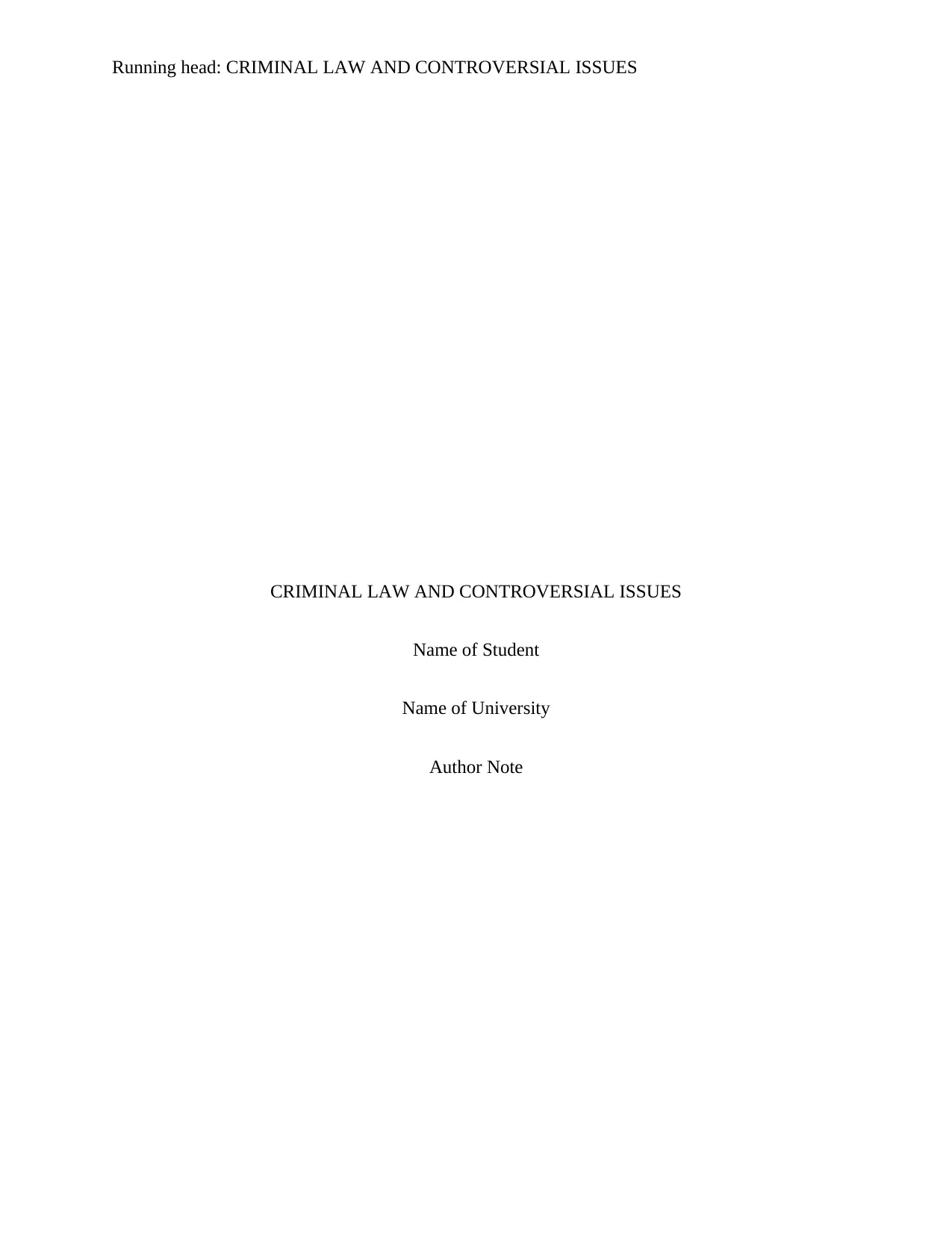
Running head: CRIMINAL LAW AND CONTROVERSIAL ISSUES
CRIMINAL LAW AND CONTROVERSIAL ISSUES
Name of Student
Name of University
Author Note
CRIMINAL LAW AND CONTROVERSIAL ISSUES
Name of Student
Name of University
Author Note
Paraphrase This Document
Need a fresh take? Get an instant paraphrase of this document with our AI Paraphraser
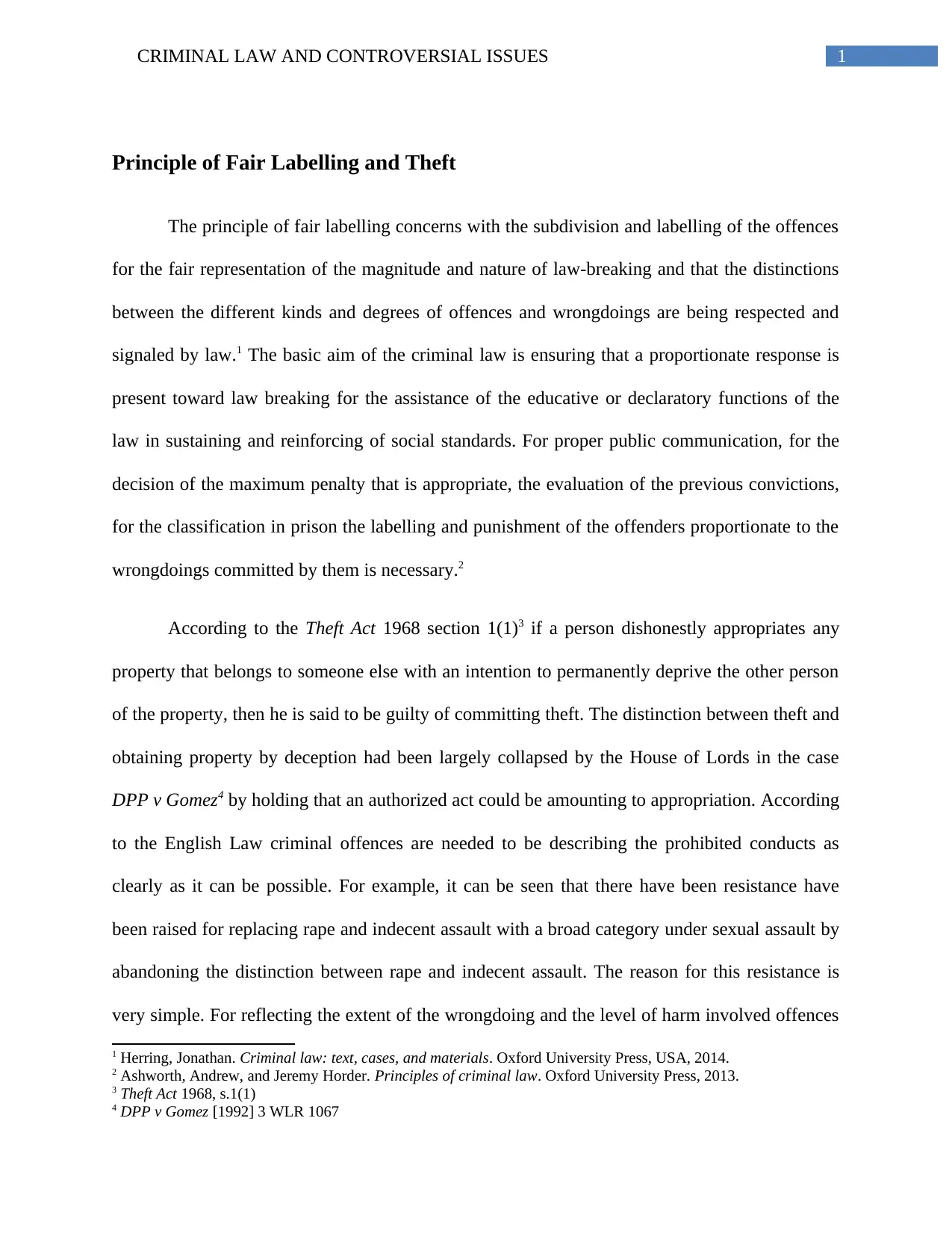
1CRIMINAL LAW AND CONTROVERSIAL ISSUES
Principle of Fair Labelling and Theft
The principle of fair labelling concerns with the subdivision and labelling of the offences
for the fair representation of the magnitude and nature of law-breaking and that the distinctions
between the different kinds and degrees of offences and wrongdoings are being respected and
signaled by law.1 The basic aim of the criminal law is ensuring that a proportionate response is
present toward law breaking for the assistance of the educative or declaratory functions of the
law in sustaining and reinforcing of social standards. For proper public communication, for the
decision of the maximum penalty that is appropriate, the evaluation of the previous convictions,
for the classification in prison the labelling and punishment of the offenders proportionate to the
wrongdoings committed by them is necessary.2
According to the Theft Act 1968 section 1(1)3 if a person dishonestly appropriates any
property that belongs to someone else with an intention to permanently deprive the other person
of the property, then he is said to be guilty of committing theft. The distinction between theft and
obtaining property by deception had been largely collapsed by the House of Lords in the case
DPP v Gomez4 by holding that an authorized act could be amounting to appropriation. According
to the English Law criminal offences are needed to be describing the prohibited conducts as
clearly as it can be possible. For example, it can be seen that there have been resistance have
been raised for replacing rape and indecent assault with a broad category under sexual assault by
abandoning the distinction between rape and indecent assault. The reason for this resistance is
very simple. For reflecting the extent of the wrongdoing and the level of harm involved offences
1 Herring, Jonathan. Criminal law: text, cases, and materials. Oxford University Press, USA, 2014.
2 Ashworth, Andrew, and Jeremy Horder. Principles of criminal law. Oxford University Press, 2013.
3 Theft Act 1968, s.1(1)
4 DPP v Gomez [1992] 3 WLR 1067
Principle of Fair Labelling and Theft
The principle of fair labelling concerns with the subdivision and labelling of the offences
for the fair representation of the magnitude and nature of law-breaking and that the distinctions
between the different kinds and degrees of offences and wrongdoings are being respected and
signaled by law.1 The basic aim of the criminal law is ensuring that a proportionate response is
present toward law breaking for the assistance of the educative or declaratory functions of the
law in sustaining and reinforcing of social standards. For proper public communication, for the
decision of the maximum penalty that is appropriate, the evaluation of the previous convictions,
for the classification in prison the labelling and punishment of the offenders proportionate to the
wrongdoings committed by them is necessary.2
According to the Theft Act 1968 section 1(1)3 if a person dishonestly appropriates any
property that belongs to someone else with an intention to permanently deprive the other person
of the property, then he is said to be guilty of committing theft. The distinction between theft and
obtaining property by deception had been largely collapsed by the House of Lords in the case
DPP v Gomez4 by holding that an authorized act could be amounting to appropriation. According
to the English Law criminal offences are needed to be describing the prohibited conducts as
clearly as it can be possible. For example, it can be seen that there have been resistance have
been raised for replacing rape and indecent assault with a broad category under sexual assault by
abandoning the distinction between rape and indecent assault. The reason for this resistance is
very simple. For reflecting the extent of the wrongdoing and the level of harm involved offences
1 Herring, Jonathan. Criminal law: text, cases, and materials. Oxford University Press, USA, 2014.
2 Ashworth, Andrew, and Jeremy Horder. Principles of criminal law. Oxford University Press, 2013.
3 Theft Act 1968, s.1(1)
4 DPP v Gomez [1992] 3 WLR 1067
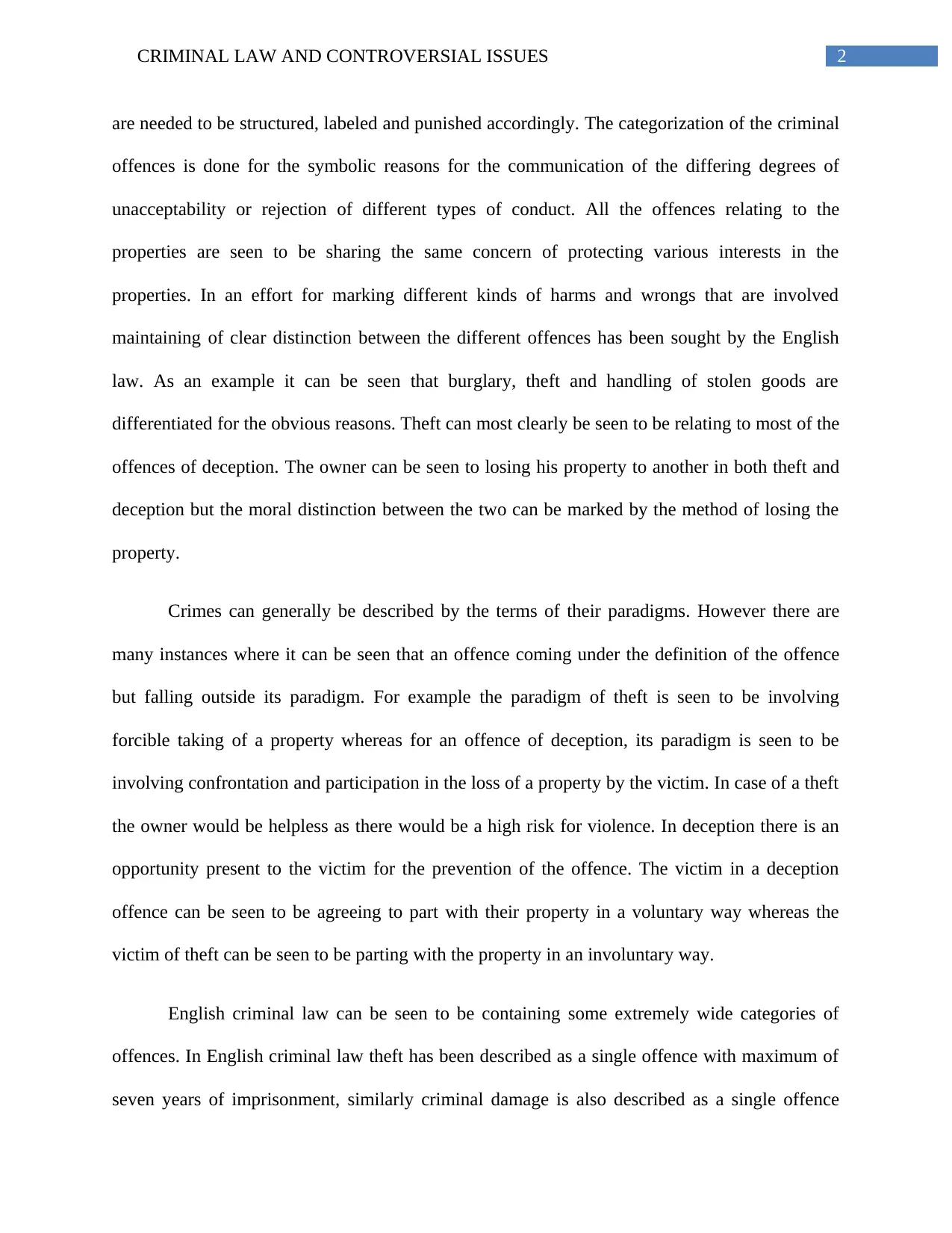
2CRIMINAL LAW AND CONTROVERSIAL ISSUES
are needed to be structured, labeled and punished accordingly. The categorization of the criminal
offences is done for the symbolic reasons for the communication of the differing degrees of
unacceptability or rejection of different types of conduct. All the offences relating to the
properties are seen to be sharing the same concern of protecting various interests in the
properties. In an effort for marking different kinds of harms and wrongs that are involved
maintaining of clear distinction between the different offences has been sought by the English
law. As an example it can be seen that burglary, theft and handling of stolen goods are
differentiated for the obvious reasons. Theft can most clearly be seen to be relating to most of the
offences of deception. The owner can be seen to losing his property to another in both theft and
deception but the moral distinction between the two can be marked by the method of losing the
property.
Crimes can generally be described by the terms of their paradigms. However there are
many instances where it can be seen that an offence coming under the definition of the offence
but falling outside its paradigm. For example the paradigm of theft is seen to be involving
forcible taking of a property whereas for an offence of deception, its paradigm is seen to be
involving confrontation and participation in the loss of a property by the victim. In case of a theft
the owner would be helpless as there would be a high risk for violence. In deception there is an
opportunity present to the victim for the prevention of the offence. The victim in a deception
offence can be seen to be agreeing to part with their property in a voluntary way whereas the
victim of theft can be seen to be parting with the property in an involuntary way.
English criminal law can be seen to be containing some extremely wide categories of
offences. In English criminal law theft has been described as a single offence with maximum of
seven years of imprisonment, similarly criminal damage is also described as a single offence
are needed to be structured, labeled and punished accordingly. The categorization of the criminal
offences is done for the symbolic reasons for the communication of the differing degrees of
unacceptability or rejection of different types of conduct. All the offences relating to the
properties are seen to be sharing the same concern of protecting various interests in the
properties. In an effort for marking different kinds of harms and wrongs that are involved
maintaining of clear distinction between the different offences has been sought by the English
law. As an example it can be seen that burglary, theft and handling of stolen goods are
differentiated for the obvious reasons. Theft can most clearly be seen to be relating to most of the
offences of deception. The owner can be seen to losing his property to another in both theft and
deception but the moral distinction between the two can be marked by the method of losing the
property.
Crimes can generally be described by the terms of their paradigms. However there are
many instances where it can be seen that an offence coming under the definition of the offence
but falling outside its paradigm. For example the paradigm of theft is seen to be involving
forcible taking of a property whereas for an offence of deception, its paradigm is seen to be
involving confrontation and participation in the loss of a property by the victim. In case of a theft
the owner would be helpless as there would be a high risk for violence. In deception there is an
opportunity present to the victim for the prevention of the offence. The victim in a deception
offence can be seen to be agreeing to part with their property in a voluntary way whereas the
victim of theft can be seen to be parting with the property in an involuntary way.
English criminal law can be seen to be containing some extremely wide categories of
offences. In English criminal law theft has been described as a single offence with maximum of
seven years of imprisonment, similarly criminal damage is also described as a single offence
⊘ This is a preview!⊘
Do you want full access?
Subscribe today to unlock all pages.

Trusted by 1+ million students worldwide
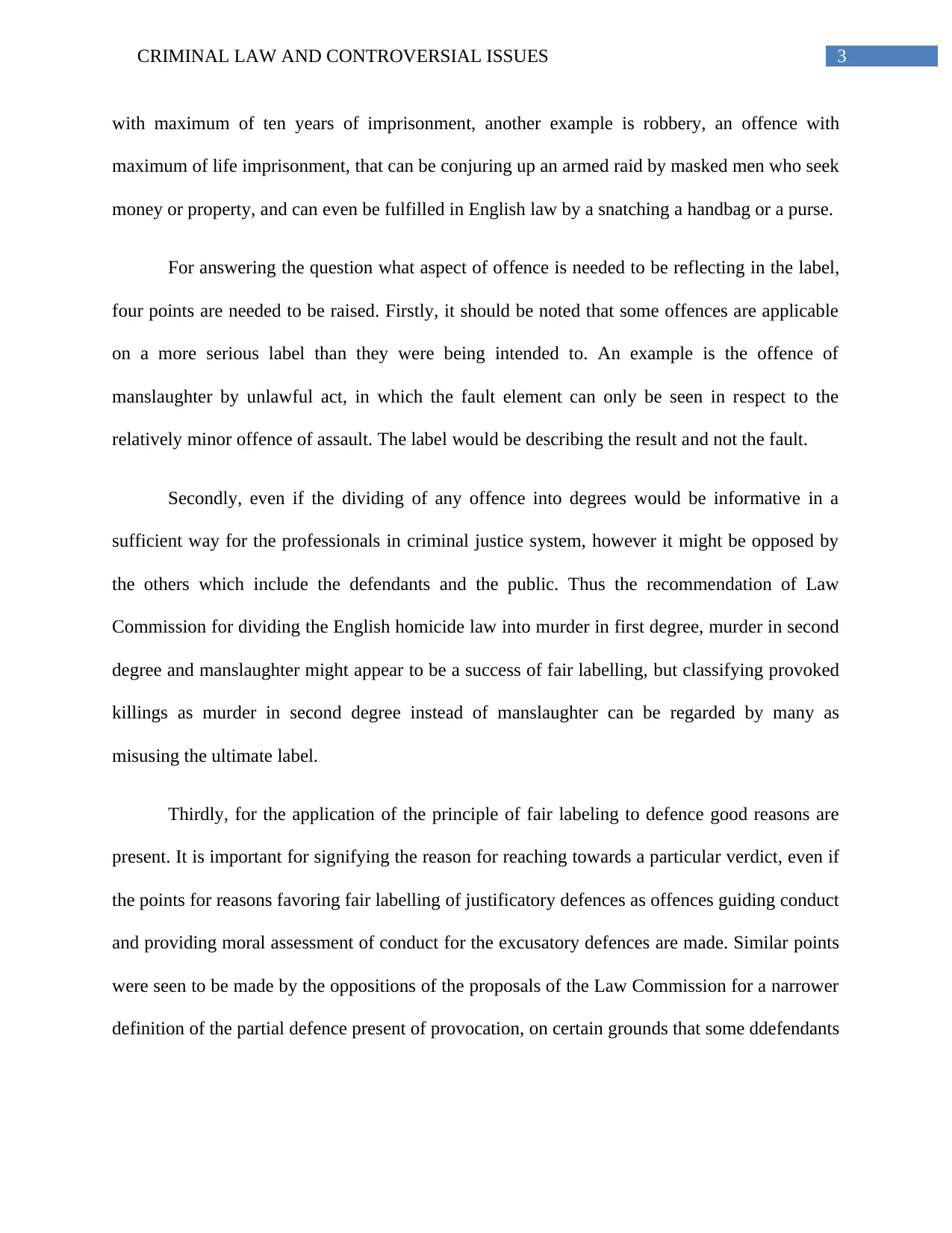
3CRIMINAL LAW AND CONTROVERSIAL ISSUES
with maximum of ten years of imprisonment, another example is robbery, an offence with
maximum of life imprisonment, that can be conjuring up an armed raid by masked men who seek
money or property, and can even be fulfilled in English law by a snatching a handbag or a purse.
For answering the question what aspect of offence is needed to be reflecting in the label,
four points are needed to be raised. Firstly, it should be noted that some offences are applicable
on a more serious label than they were being intended to. An example is the offence of
manslaughter by unlawful act, in which the fault element can only be seen in respect to the
relatively minor offence of assault. The label would be describing the result and not the fault.
Secondly, even if the dividing of any offence into degrees would be informative in a
sufficient way for the professionals in criminal justice system, however it might be opposed by
the others which include the defendants and the public. Thus the recommendation of Law
Commission for dividing the English homicide law into murder in first degree, murder in second
degree and manslaughter might appear to be a success of fair labelling, but classifying provoked
killings as murder in second degree instead of manslaughter can be regarded by many as
misusing the ultimate label.
Thirdly, for the application of the principle of fair labeling to defence good reasons are
present. It is important for signifying the reason for reaching towards a particular verdict, even if
the points for reasons favoring fair labelling of justificatory defences as offences guiding conduct
and providing moral assessment of conduct for the excusatory defences are made. Similar points
were seen to be made by the oppositions of the proposals of the Law Commission for a narrower
definition of the partial defence present of provocation, on certain grounds that some ddefendants
with maximum of ten years of imprisonment, another example is robbery, an offence with
maximum of life imprisonment, that can be conjuring up an armed raid by masked men who seek
money or property, and can even be fulfilled in English law by a snatching a handbag or a purse.
For answering the question what aspect of offence is needed to be reflecting in the label,
four points are needed to be raised. Firstly, it should be noted that some offences are applicable
on a more serious label than they were being intended to. An example is the offence of
manslaughter by unlawful act, in which the fault element can only be seen in respect to the
relatively minor offence of assault. The label would be describing the result and not the fault.
Secondly, even if the dividing of any offence into degrees would be informative in a
sufficient way for the professionals in criminal justice system, however it might be opposed by
the others which include the defendants and the public. Thus the recommendation of Law
Commission for dividing the English homicide law into murder in first degree, murder in second
degree and manslaughter might appear to be a success of fair labelling, but classifying provoked
killings as murder in second degree instead of manslaughter can be regarded by many as
misusing the ultimate label.
Thirdly, for the application of the principle of fair labeling to defence good reasons are
present. It is important for signifying the reason for reaching towards a particular verdict, even if
the points for reasons favoring fair labelling of justificatory defences as offences guiding conduct
and providing moral assessment of conduct for the excusatory defences are made. Similar points
were seen to be made by the oppositions of the proposals of the Law Commission for a narrower
definition of the partial defence present of provocation, on certain grounds that some ddefendants
Paraphrase This Document
Need a fresh take? Get an instant paraphrase of this document with our AI Paraphraser
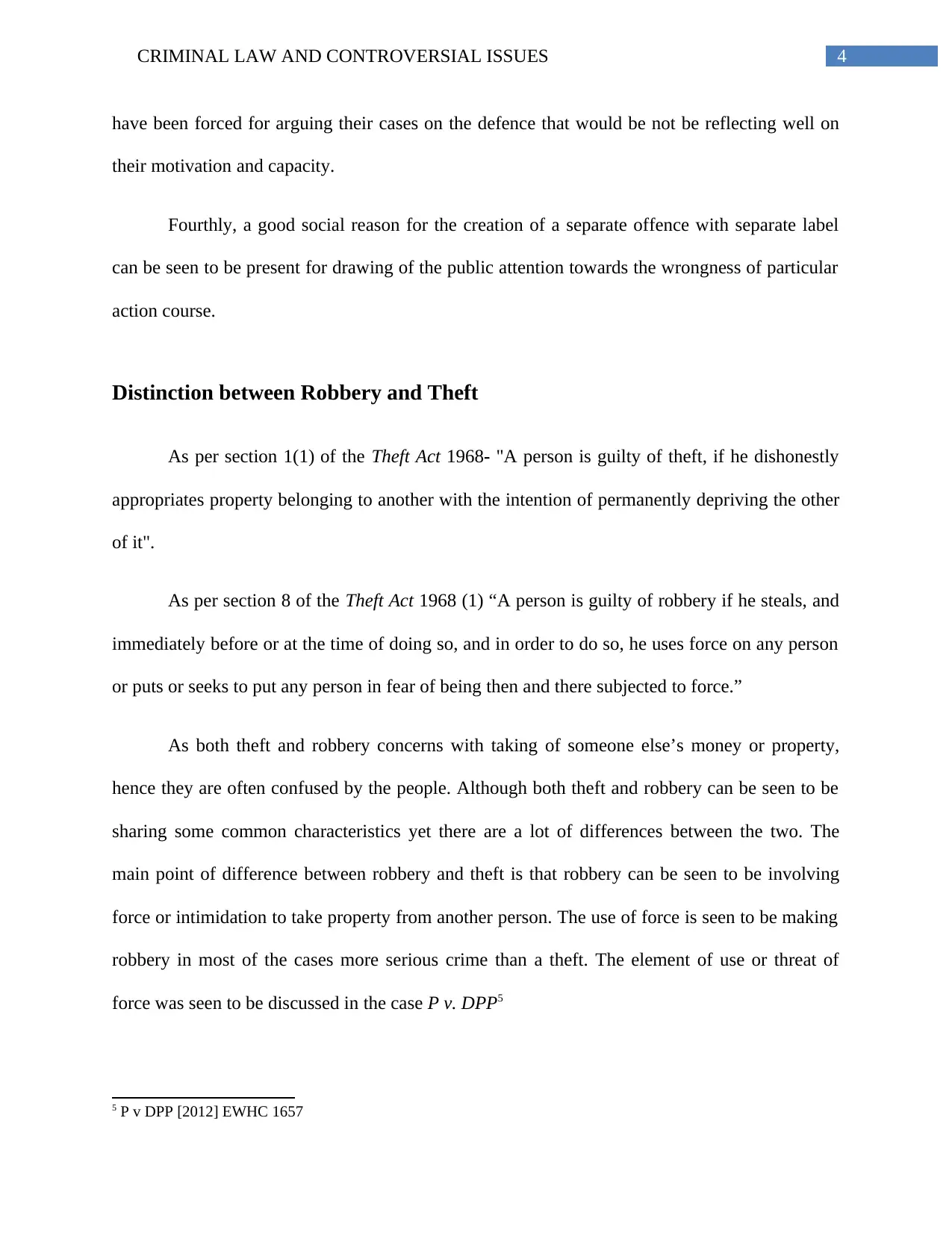
4CRIMINAL LAW AND CONTROVERSIAL ISSUES
have been forced for arguing their cases on the defence that would be not be reflecting well on
their motivation and capacity.
Fourthly, a good social reason for the creation of a separate offence with separate label
can be seen to be present for drawing of the public attention towards the wrongness of particular
action course.
Distinction between Robbery and Theft
As per section 1(1) of the Theft Act 1968- "A person is guilty of theft, if he dishonestly
appropriates property belonging to another with the intention of permanently depriving the other
of it".
As per section 8 of the Theft Act 1968 (1) “A person is guilty of robbery if he steals, and
immediately before or at the time of doing so, and in order to do so, he uses force on any person
or puts or seeks to put any person in fear of being then and there subjected to force.”
As both theft and robbery concerns with taking of someone else’s money or property,
hence they are often confused by the people. Although both theft and robbery can be seen to be
sharing some common characteristics yet there are a lot of differences between the two. The
main point of difference between robbery and theft is that robbery can be seen to be involving
force or intimidation to take property from another person. The use of force is seen to be making
robbery in most of the cases more serious crime than a theft. The element of use or threat of
force was seen to be discussed in the case P v. DPP5
5 P v DPP [2012] EWHC 1657
have been forced for arguing their cases on the defence that would be not be reflecting well on
their motivation and capacity.
Fourthly, a good social reason for the creation of a separate offence with separate label
can be seen to be present for drawing of the public attention towards the wrongness of particular
action course.
Distinction between Robbery and Theft
As per section 1(1) of the Theft Act 1968- "A person is guilty of theft, if he dishonestly
appropriates property belonging to another with the intention of permanently depriving the other
of it".
As per section 8 of the Theft Act 1968 (1) “A person is guilty of robbery if he steals, and
immediately before or at the time of doing so, and in order to do so, he uses force on any person
or puts or seeks to put any person in fear of being then and there subjected to force.”
As both theft and robbery concerns with taking of someone else’s money or property,
hence they are often confused by the people. Although both theft and robbery can be seen to be
sharing some common characteristics yet there are a lot of differences between the two. The
main point of difference between robbery and theft is that robbery can be seen to be involving
force or intimidation to take property from another person. The use of force is seen to be making
robbery in most of the cases more serious crime than a theft. The element of use or threat of
force was seen to be discussed in the case P v. DPP5
5 P v DPP [2012] EWHC 1657
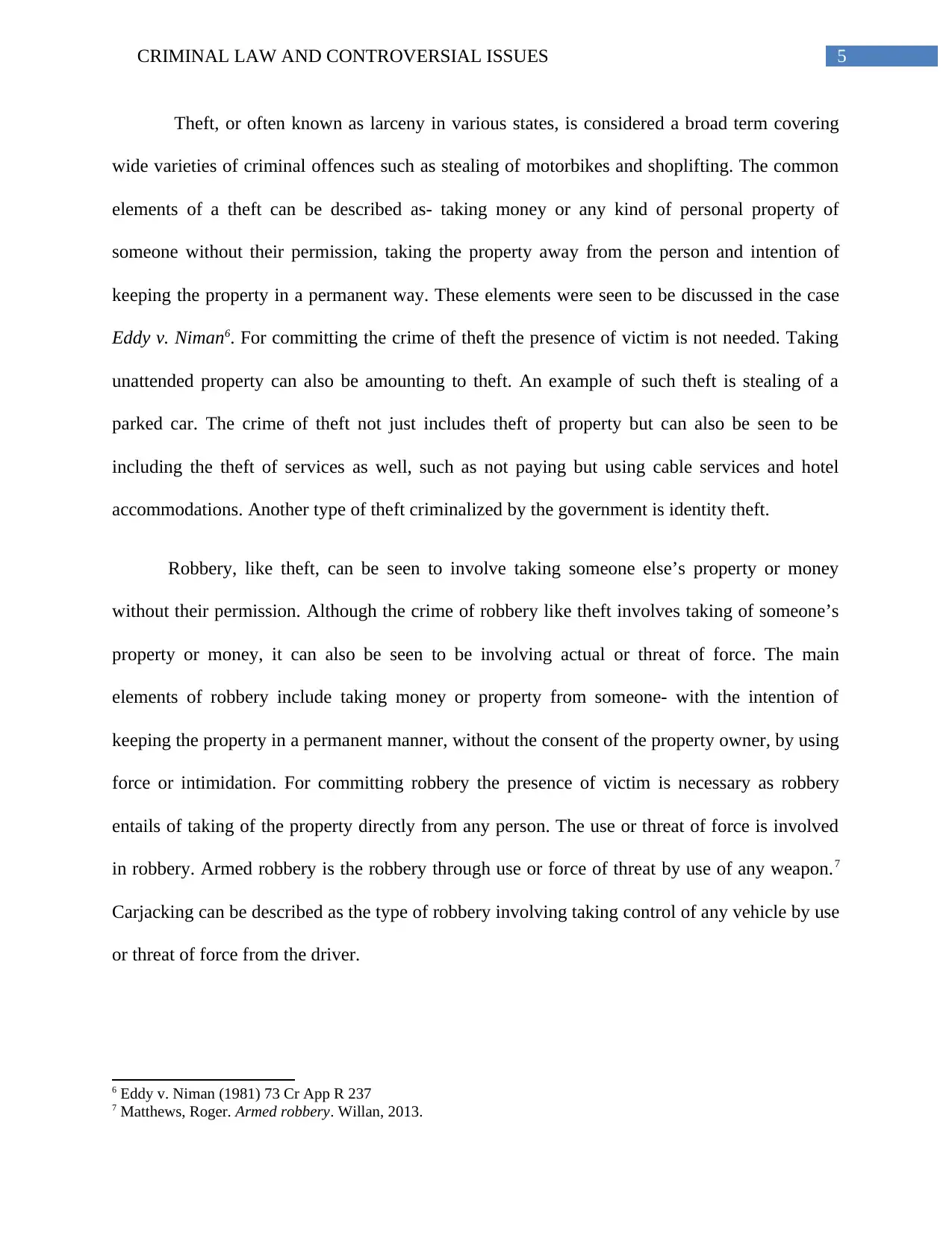
5CRIMINAL LAW AND CONTROVERSIAL ISSUES
Theft, or often known as larceny in various states, is considered a broad term covering
wide varieties of criminal offences such as stealing of motorbikes and shoplifting. The common
elements of a theft can be described as- taking money or any kind of personal property of
someone without their permission, taking the property away from the person and intention of
keeping the property in a permanent way. These elements were seen to be discussed in the case
Eddy v. Niman6. For committing the crime of theft the presence of victim is not needed. Taking
unattended property can also be amounting to theft. An example of such theft is stealing of a
parked car. The crime of theft not just includes theft of property but can also be seen to be
including the theft of services as well, such as not paying but using cable services and hotel
accommodations. Another type of theft criminalized by the government is identity theft.
Robbery, like theft, can be seen to involve taking someone else’s property or money
without their permission. Although the crime of robbery like theft involves taking of someone’s
property or money, it can also be seen to be involving actual or threat of force. The main
elements of robbery include taking money or property from someone- with the intention of
keeping the property in a permanent manner, without the consent of the property owner, by using
force or intimidation. For committing robbery the presence of victim is necessary as robbery
entails of taking of the property directly from any person. The use or threat of force is involved
in robbery. Armed robbery is the robbery through use or force of threat by use of any weapon.7
Carjacking can be described as the type of robbery involving taking control of any vehicle by use
or threat of force from the driver.
6 Eddy v. Niman (1981) 73 Cr App R 237
7 Matthews, Roger. Armed robbery. Willan, 2013.
Theft, or often known as larceny in various states, is considered a broad term covering
wide varieties of criminal offences such as stealing of motorbikes and shoplifting. The common
elements of a theft can be described as- taking money or any kind of personal property of
someone without their permission, taking the property away from the person and intention of
keeping the property in a permanent way. These elements were seen to be discussed in the case
Eddy v. Niman6. For committing the crime of theft the presence of victim is not needed. Taking
unattended property can also be amounting to theft. An example of such theft is stealing of a
parked car. The crime of theft not just includes theft of property but can also be seen to be
including the theft of services as well, such as not paying but using cable services and hotel
accommodations. Another type of theft criminalized by the government is identity theft.
Robbery, like theft, can be seen to involve taking someone else’s property or money
without their permission. Although the crime of robbery like theft involves taking of someone’s
property or money, it can also be seen to be involving actual or threat of force. The main
elements of robbery include taking money or property from someone- with the intention of
keeping the property in a permanent manner, without the consent of the property owner, by using
force or intimidation. For committing robbery the presence of victim is necessary as robbery
entails of taking of the property directly from any person. The use or threat of force is involved
in robbery. Armed robbery is the robbery through use or force of threat by use of any weapon.7
Carjacking can be described as the type of robbery involving taking control of any vehicle by use
or threat of force from the driver.
6 Eddy v. Niman (1981) 73 Cr App R 237
7 Matthews, Roger. Armed robbery. Willan, 2013.
⊘ This is a preview!⊘
Do you want full access?
Subscribe today to unlock all pages.

Trusted by 1+ million students worldwide
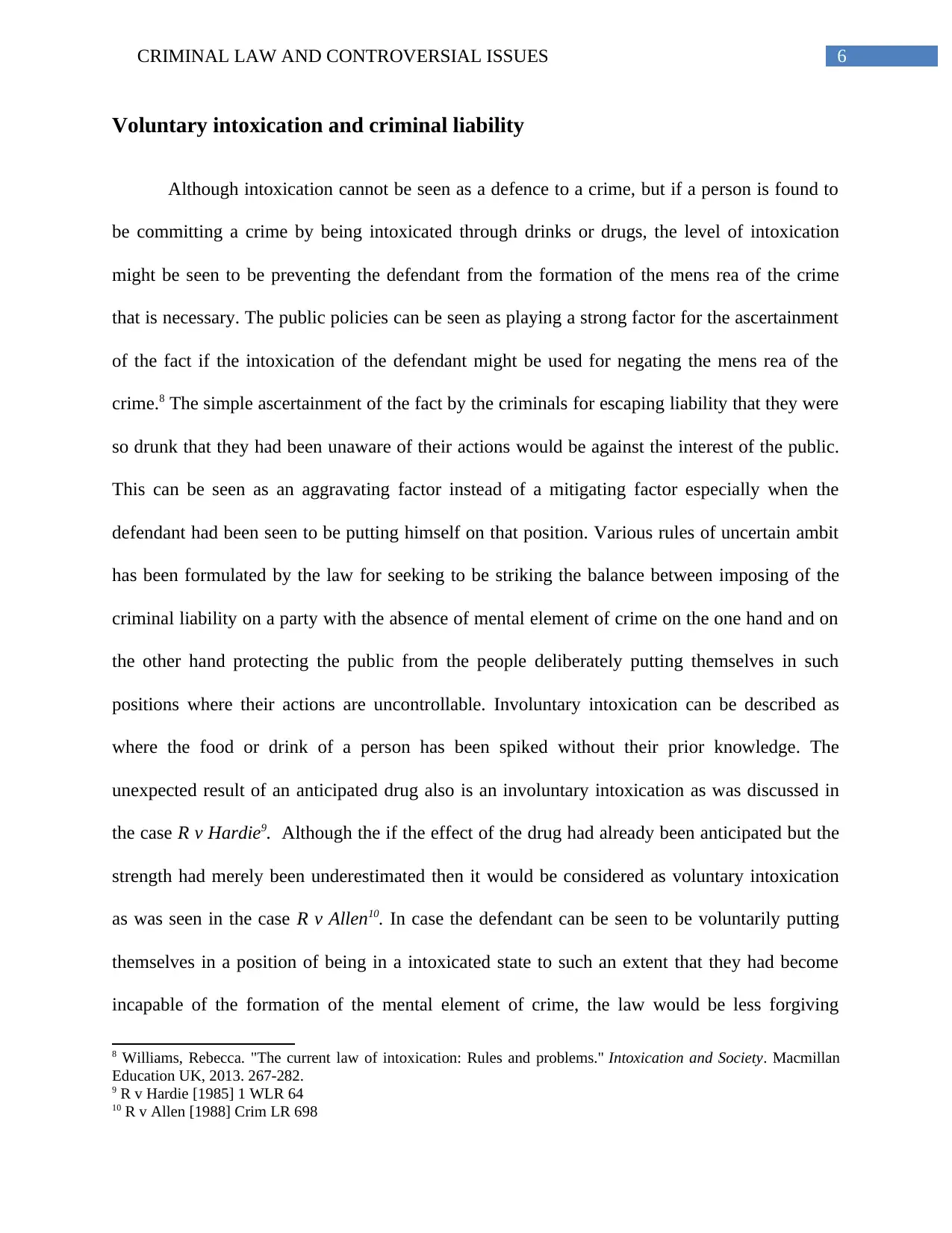
6CRIMINAL LAW AND CONTROVERSIAL ISSUES
Voluntary intoxication and criminal liability
Although intoxication cannot be seen as a defence to a crime, but if a person is found to
be committing a crime by being intoxicated through drinks or drugs, the level of intoxication
might be seen to be preventing the defendant from the formation of the mens rea of the crime
that is necessary. The public policies can be seen as playing a strong factor for the ascertainment
of the fact if the intoxication of the defendant might be used for negating the mens rea of the
crime.8 The simple ascertainment of the fact by the criminals for escaping liability that they were
so drunk that they had been unaware of their actions would be against the interest of the public.
This can be seen as an aggravating factor instead of a mitigating factor especially when the
defendant had been seen to be putting himself on that position. Various rules of uncertain ambit
has been formulated by the law for seeking to be striking the balance between imposing of the
criminal liability on a party with the absence of mental element of crime on the one hand and on
the other hand protecting the public from the people deliberately putting themselves in such
positions where their actions are uncontrollable. Involuntary intoxication can be described as
where the food or drink of a person has been spiked without their prior knowledge. The
unexpected result of an anticipated drug also is an involuntary intoxication as was discussed in
the case R v Hardie9. Although the if the effect of the drug had already been anticipated but the
strength had merely been underestimated then it would be considered as voluntary intoxication
as was seen in the case R v Allen10. In case the defendant can be seen to be voluntarily putting
themselves in a position of being in a intoxicated state to such an extent that they had become
incapable of the formation of the mental element of crime, the law would be less forgiving
8 Williams, Rebecca. "The current law of intoxication: Rules and problems." Intoxication and Society. Macmillan
Education UK, 2013. 267-282.
9 R v Hardie [1985] 1 WLR 64
10 R v Allen [1988] Crim LR 698
Voluntary intoxication and criminal liability
Although intoxication cannot be seen as a defence to a crime, but if a person is found to
be committing a crime by being intoxicated through drinks or drugs, the level of intoxication
might be seen to be preventing the defendant from the formation of the mens rea of the crime
that is necessary. The public policies can be seen as playing a strong factor for the ascertainment
of the fact if the intoxication of the defendant might be used for negating the mens rea of the
crime.8 The simple ascertainment of the fact by the criminals for escaping liability that they were
so drunk that they had been unaware of their actions would be against the interest of the public.
This can be seen as an aggravating factor instead of a mitigating factor especially when the
defendant had been seen to be putting himself on that position. Various rules of uncertain ambit
has been formulated by the law for seeking to be striking the balance between imposing of the
criminal liability on a party with the absence of mental element of crime on the one hand and on
the other hand protecting the public from the people deliberately putting themselves in such
positions where their actions are uncontrollable. Involuntary intoxication can be described as
where the food or drink of a person has been spiked without their prior knowledge. The
unexpected result of an anticipated drug also is an involuntary intoxication as was discussed in
the case R v Hardie9. Although the if the effect of the drug had already been anticipated but the
strength had merely been underestimated then it would be considered as voluntary intoxication
as was seen in the case R v Allen10. In case the defendant can be seen to be voluntarily putting
themselves in a position of being in a intoxicated state to such an extent that they had become
incapable of the formation of the mental element of crime, the law would be less forgiving
8 Williams, Rebecca. "The current law of intoxication: Rules and problems." Intoxication and Society. Macmillan
Education UK, 2013. 267-282.
9 R v Hardie [1985] 1 WLR 64
10 R v Allen [1988] Crim LR 698
Paraphrase This Document
Need a fresh take? Get an instant paraphrase of this document with our AI Paraphraser
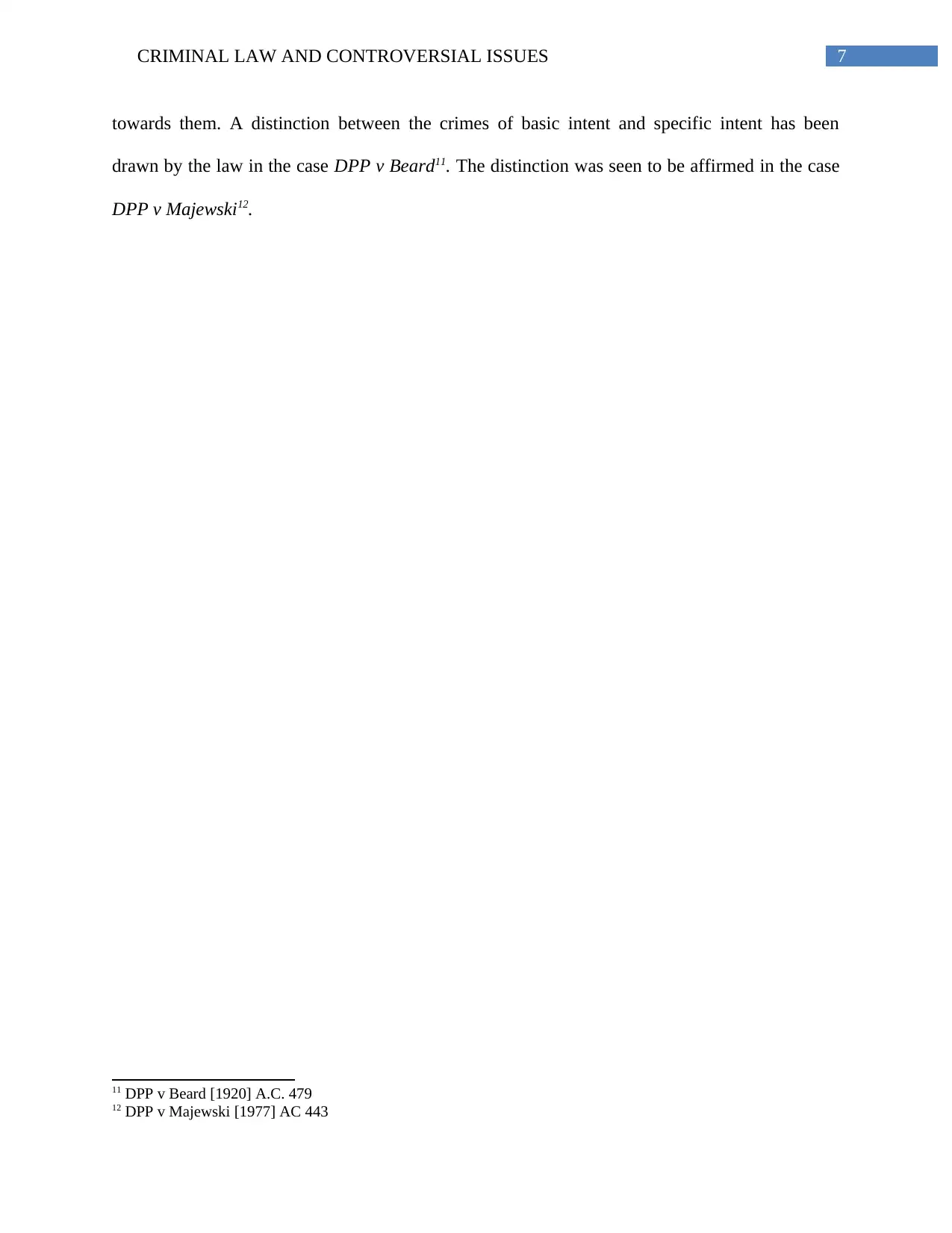
7CRIMINAL LAW AND CONTROVERSIAL ISSUES
towards them. A distinction between the crimes of basic intent and specific intent has been
drawn by the law in the case DPP v Beard11. The distinction was seen to be affirmed in the case
DPP v Majewski12.
11 DPP v Beard [1920] A.C. 479
12 DPP v Majewski [1977] AC 443
towards them. A distinction between the crimes of basic intent and specific intent has been
drawn by the law in the case DPP v Beard11. The distinction was seen to be affirmed in the case
DPP v Majewski12.
11 DPP v Beard [1920] A.C. 479
12 DPP v Majewski [1977] AC 443
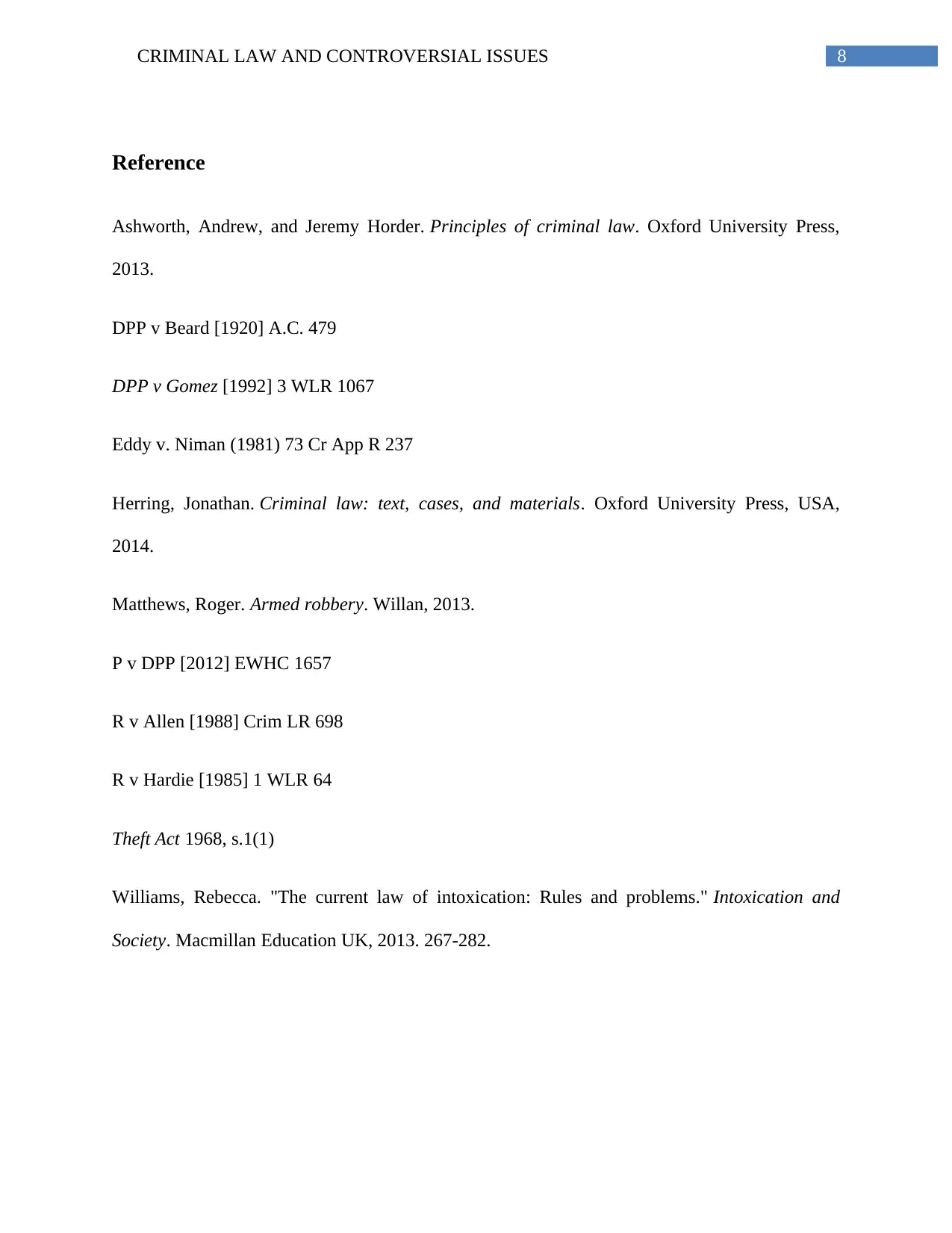
8CRIMINAL LAW AND CONTROVERSIAL ISSUES
Reference
Ashworth, Andrew, and Jeremy Horder. Principles of criminal law. Oxford University Press,
2013.
DPP v Beard [1920] A.C. 479
DPP v Gomez [1992] 3 WLR 1067
Eddy v. Niman (1981) 73 Cr App R 237
Herring, Jonathan. Criminal law: text, cases, and materials. Oxford University Press, USA,
2014.
Matthews, Roger. Armed robbery. Willan, 2013.
P v DPP [2012] EWHC 1657
R v Allen [1988] Crim LR 698
R v Hardie [1985] 1 WLR 64
Theft Act 1968, s.1(1)
Williams, Rebecca. "The current law of intoxication: Rules and problems." Intoxication and
Society. Macmillan Education UK, 2013. 267-282.
Reference
Ashworth, Andrew, and Jeremy Horder. Principles of criminal law. Oxford University Press,
2013.
DPP v Beard [1920] A.C. 479
DPP v Gomez [1992] 3 WLR 1067
Eddy v. Niman (1981) 73 Cr App R 237
Herring, Jonathan. Criminal law: text, cases, and materials. Oxford University Press, USA,
2014.
Matthews, Roger. Armed robbery. Willan, 2013.
P v DPP [2012] EWHC 1657
R v Allen [1988] Crim LR 698
R v Hardie [1985] 1 WLR 64
Theft Act 1968, s.1(1)
Williams, Rebecca. "The current law of intoxication: Rules and problems." Intoxication and
Society. Macmillan Education UK, 2013. 267-282.
⊘ This is a preview!⊘
Do you want full access?
Subscribe today to unlock all pages.

Trusted by 1+ million students worldwide
1 out of 9
Your All-in-One AI-Powered Toolkit for Academic Success.
+13062052269
info@desklib.com
Available 24*7 on WhatsApp / Email
![[object Object]](/_next/static/media/star-bottom.7253800d.svg)
Unlock your academic potential
Copyright © 2020–2025 A2Z Services. All Rights Reserved. Developed and managed by ZUCOL.